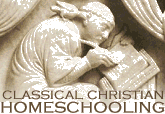


Text Only
Classical Christian WebMaster: CCH’s Online Catalog: Geographic Exploration and Cartography - Grades 2-6 This page last revised: Copyright © 1997-2001 |
Geographic Exploration & Cartography: Grades 2-6Man’s discovery of the world around him, and the development of the science of map-making, is an interesting and exciting story. Include these suggestions with your history study to cover this important but often neglected aspect of geography instruction. Using the Online Catalog
For the 2nd grade. All educated people and sailors since the time
of the Greeks knew that the earth was round. The standard geography text in universities
throughout the Middle Ages was Ptolemy’s Geography, which stated the earth was
round. This book contains the story of how the Greeks knew it to be round by logic,
through the voyage of Magellan who proved it beyond the shadow of a doubt. Readers can
follow the development of a scientific concept that began centuries ago with the help of
hands-on activities that enable them to re-create the Greeks’ studies. A 1990 Notable
Children’s Trade Book in the Field of Social Studies.
For the 2nd-3rd grades. The story of the life and discoveries of
Eratosthenes, the librarian of the great library of Alexandria. He measured the
circumference of the earth accurately by using logic, geometry, and research (he was only
off by 200 miles!) in the 3rd century B.C. To emphasize his achievement, we didn’t
figure out the accurate circumference of the earth until this century. All ages will enjoy
the delightful narrative and illustrations.
For the 3rd-4th grades. The in-print counterpart that could be
used instead of Great Adventures That Changed Our World, but unfortunately without
the depth of scope. Still, this provides an interesting overview of the history of
exploration of all the areas of the world and who explored them, from Columbus through
Neil Armstrong.
For the 4th-6th grades. Subtitled: the World’s Great
Explorers, Their Triumphs and Tragedies. The history of exploration, beginning with the
Phoenicians through the manned-space missions, replete with maps, photographs, and the
fascinating stories behind the facts. This book goes into much greater detail than the
Usborne book, and covers the explorations of the Phoenicians, Vikings, Marco Polo, Henry
the Navigator, Columbus, Vasco da Gama, Magellan, the Conquistadors, the search for the
Northwest Passage, charting the Pacific, the treks of discovery of Canada, the United
States, and Australia, Africa, the North and South Pole, and the exploration of the ocean
depths and outer space. Excellent--well worth searching for. Later grammar stage students
to read independently, but interesting to all ages read aloud.
For the 4th-6th grades. “This thoroughly fascinating history
of cartography ranges from the birchbark maps of the early Indians and clay tablets of the
Babylonians right up to the Global Positioning System of today... Great resource book for
teachers, and lovers of maps or history.” So says the Parent Council review. This is
the best book on the history of cartography for kids that I have seen. Using the Online CatalogThis online catalog is made possible through an association with Amazon.com. Clicking on the book cover will take you to Amazon’s information page about that book. You can look at its price, availability, any discounts currently taken for that title, reviews of the book, and other information, as well as order it if you decide to purchase the book. You can even place books in your shopping cart and save them for purchase at a later time. You can continue to add or delete books from your shopping cart until you are satisfied with your order and ready to purchase. Clicking on your browser’s “Back” button will bring you back to this catalog. Sometimes books go out of print, or the publisher runs out of stock. Any book not available from Amazon.com for any reason can be searched using AddAll.com, a book shopping site which will scan Amazon as well as Barnes and Noble, Powell’s Books, Book Close Outs and many other new and used book sites. Be sure to also check BookFinder.com for out of print book searches. Still have questions? Ask me! Return to the CatalogCCH’s Geography CurriculumGeography in the Grammar StageOnline Catalog IndexClassical Curriculum and Online Catalog
|
Home ××× Contents ××× About ××× New ××× Curriculum ××× FAQ
|